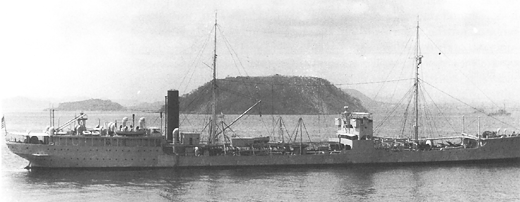 Kanawha/Cuyama Class
Kanawha/Cuyama Class
The big
American fleet oiler AO-1 USS Kanawha sits upright near the entrance to
Tulaghi Harbour at about 60 metres (200 ft). It was built in 1914, is 476 feet
long, 56 feet wide and displaced 14,500 tons.
The ship was sunk in 1943 by bombs from Japanese aircraft.
As a warship, it was heavily armed with guns on the bow, bridge, midships
and stern. Because of the limited bottom time, dives are conducted from the
submerged mooring lines on either the bow or the stern. As this ship is an old
tanker design, it is well worthwhile studying historical photographs of the ship
to get an idea of its layout.
My dive guide was Neil Yates who operates
Solomon
Islands Diving in Tulagi, Nggela (Florida) Islands, Solomon Islands.
The
dive
shop has two compressors, lots of tanks, twins, ponies,
good quality BCDs, regs and tank bands.
Although
we did not need to use the safety equipment that had been put in place before
the dives, it was reassuring to see that I was diving with a very professional
operator.
Stern Dive
In preparation for this dive, I bolted my
Poseidon Tech BCD to a pair of alloy 88s which were joined together by an
isolation manifold. I then fitted my Scubapro reg to the right tank, and my
Poseidon Jetstream left-handed on the left tank. A polypropylene suit was all
that was needed in the 28-degree water, and with the sheer weight of the
tanks, lead weights were entirely unnecessary.
Neil Yates tied up to the submerged
mooring and we dropped straight down to the stern of this massive old ship.
The set of twin 88s made me negatively buoyant as I plummeted straight down
the mooring line until I reached the engine room skylights at the stern of the
USS Kanawha. Neil and I had a brief “Is everything OK?”
conversation in sign language, then he led the way down through a big hole to
have a quick look at the reciprocating steam engines. Surrounded by a
shattered engine room and forcing my brain to work under the effect of
nitrogen narcosis, I was pleased to see that my new torch worked well at 55
metres!
The engine room has been badly shattered
by bombs, salvage attempts and earthquakes, so it is rather cluttered with
catwalks and other unidentifiable bits and pieces everywhere. I tried to look
around and take it all in, but it was dark, deep and our bottom time was very
short. Neil pointed out a huge broken piston, then we eased over to the
starboard side, slid through a narrow gap in the steel frame and moved up into
the accommodation area.
Out on the deck at about 48 metres, we
were confronted by two 5-inch guns pointing over the stern, a large AA gun
above them complete with empty shell casings and a US Army helmet in
reasonable condition, and 20 mm AA guns nearby. We drifted forward past the
mooring line towards the funnel and briefly examined the area in front of the
sterncastle. After only 18 minutes of bottom time, it was time for the long,
slow ascent to the surface.
We climbed hand over hand up the mooring
line with a deep stop at 18 metres. During the 22 minutes of decompression, we
used a 40 per cent Nitrox mix to flush the Nitrogen from our tissues. As an
additional safety precaution, there were two oxygen regulators on long hoses
which dropped down from a big bottle on board the dive boat. On the surface,
we handed all the gear to Dillon in the boat, climbed aboard and hydrated
ourselves with a litre of tank water.
Bow Dive
Our dive
plan was to explore the forward half of the ship at deck level (about 45 metres)
and return to the bow after 17 minutes with 100 bar in our single 88s for the
ascent and decompression stops. With 32
cu ft pony bottles clipped diagonally across our chests, we dropped down the
mooring line until the massive bow of the USS Kanawha appeared out of the
blue at about 40 metres.
Neil Yates led
the way over the port side past a large anchor that is still secured in place.
We then entered the forecastle for a well-lit penetration and emerged through
the starboard entrance. Swimming along the deck, there is much to see although
my memory is a little hazy from the narcosis!
The bridge on this old tanker is an elevated structure forward of
midships and is badly damaged. There are two big guns on either side of midships
where we turned around and headed back to the bow. My computer was beeping and
racking up the decompression time as we returned past the winch and bow guns to
the mooring line.
We ascended hand over hand up the mooring line with a deep stop at 18
metres. Neil rolled up the transit line as we swam across to the
third deco bar. There was a safety tank with two regulators attached to this
deco bar, and two oxygen regulators on long hoses from a big bottle on board the
dive boat. On the surface, we handed all the gear to Aba in the boat, climbed
aboard and hydrated ourselves with a litre of tank water.
For more information on the USS Kanawha and archival photos, see the
NavSource
Naval History website or the HyperWar
Project website.